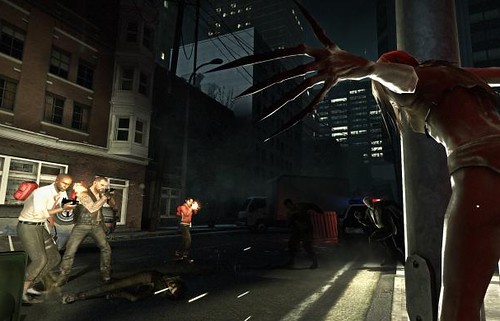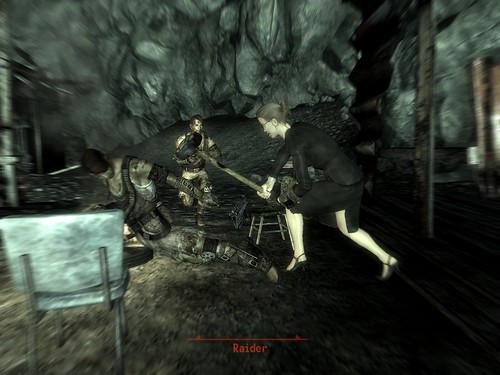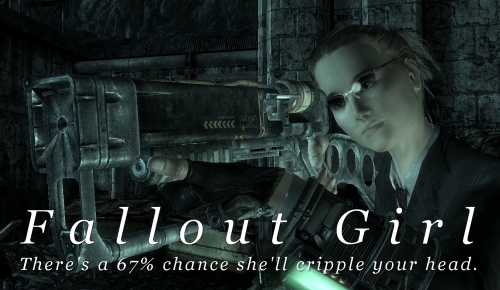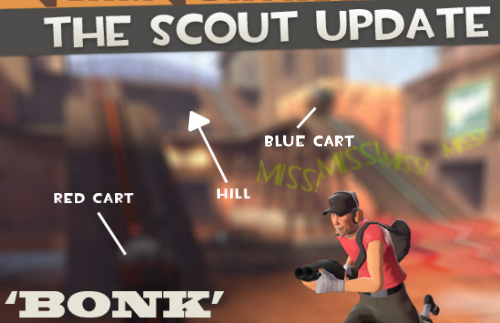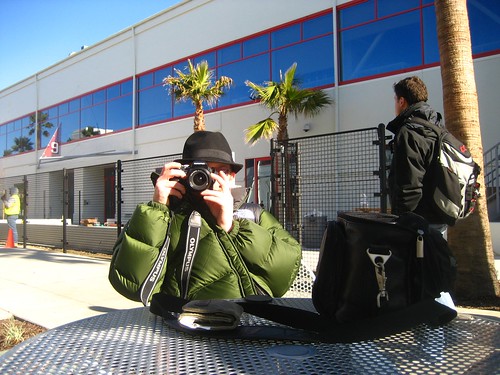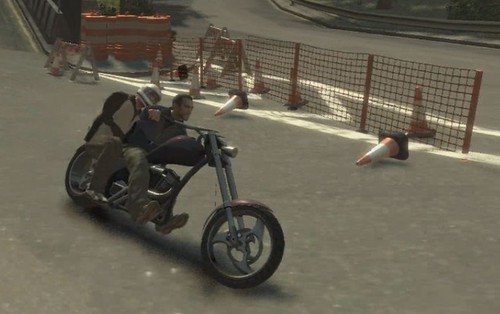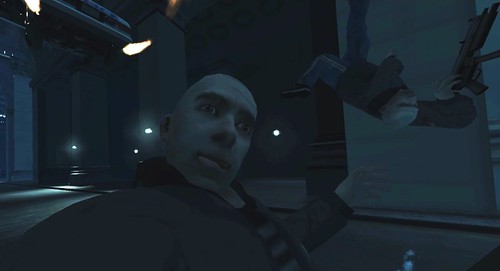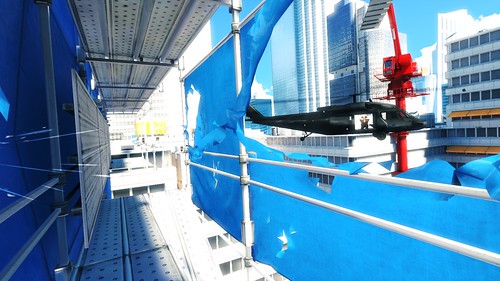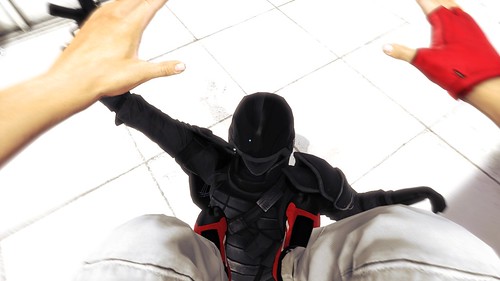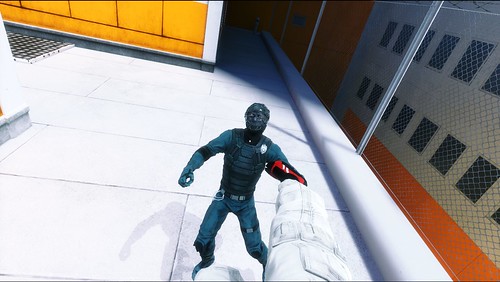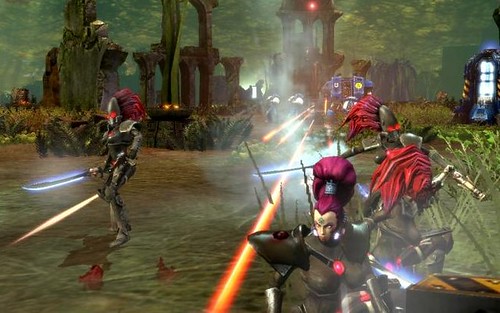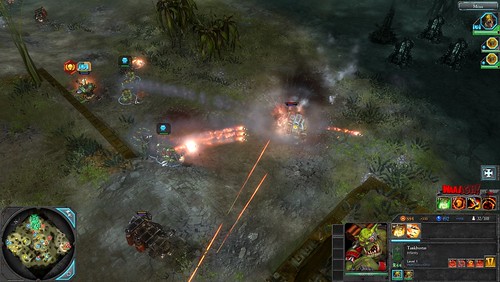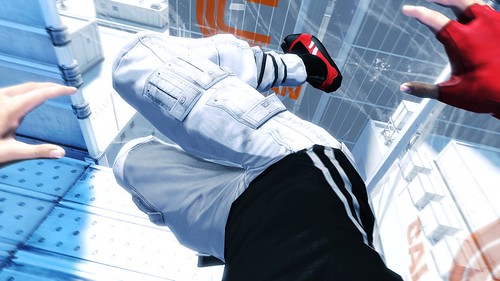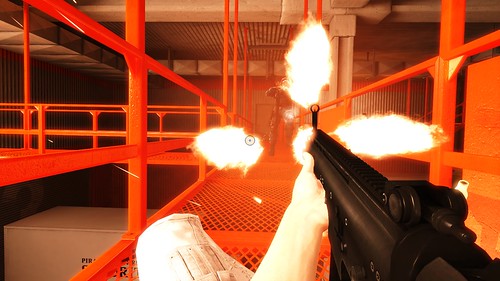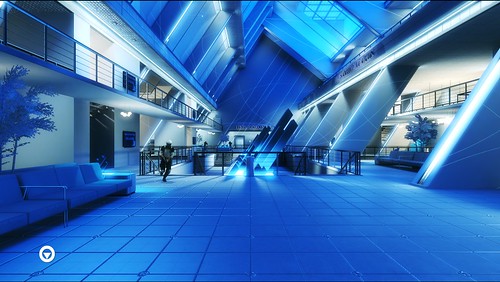TOM FRANCIS
REGRETS THIS ALREADY
Hello! I'm Tom. I'm a game designer, writer, and programmer on Gunpoint, Heat Signature, and Tactical Breach Wizards. Here's some more info on all the games I've worked on, here are the videos I make on YouTube, and here are two short stories I wrote for the Machine of Death collections.
Theme
By me. Uses Adaptive Images by Matt Wilcox.
Search
The Nameless Mod Is Out, Apparently Great
I’ve been waiting for this enormous, surreal, self-referential net-culture conversion of Deus Ex for ages. It finally came out today, so I immediately carried on playing the game I was reviewing this weekend and then sat outside and wrote it up and then cooked a meal and watched a bit of TV and talked to Kim for a while. But then, right away, I read a review of it.
Richard Cobbett gives it an enormous and extremely enthusiastic write-up on his blog, which makes a good read while the 923MB file is downloading. Lead Designer Jonas Wæver often chimes in here on James, so I’m glad to hear his work wasn’t wasted. I’ll update this post once I’ve given it a fair shake.
If you find your reading and connection speeds are such that you finish Richard’s review some minutes before the mod itself has downloaded, I can recommend from first-hand experience writing a blog post about its availability and the fact that you haven’t played it yet. It leads immediately to enormous popularity and profit.
Update: I’ve played it! A bit. I did the whole training section and watched the intro in full, so I didn’t actually get far into the game proper in the time. I dig the manned security camera mechanic, whereby you can eliminate the guy watching the monitors to neutralise one.
It was actually a guy watching monitors who saw me when I was sneaking around the apartment vents, though, and I had to grab a screwdriver from his desk to stab him in the back of the head with as he set off the alarm. That screwdriver saw some pretty heavy use before I finally succumbed to the summoned security forces, so I think I need to up the difficulty. And not sneak around stabbing security guards with screwdrivers.
All very impressive, and Richard is right, it adopts the Deus Ex motifs well. The voice of the main character seemed particularly good, as far as I played.
I Was Here
San Francisco looked strange from the plane, like a building-farm. I was back there to see a very different studio this time, though I can’t talk about that yet, and also managed to do different stuff with my spare time. Last trip Steve Gaynor, who I only knew vaguely online, was nice enough to meet up for lunch, and this time 2D Boy joined me for a fancy tea. I very much like developers who are able to perceive journalists as humans rather than organs of the industry, even when perhaps not all of them warrant the status.
With a little luck and a lot of generosity, I was also able to hitch a lift with the guys who made Lugaru down to the birthday party of the guy who made Gish, alongside the guy who made Spelunky, there to sip Guinness with one of the aforementioned guys who made World of Goo, the guy who made Bridge Builder, and the guy who made Braid. There was a dangerous concentration of genius in the room, so true to my promise to pocket my journalist hat, I was careful not to ask any good questions of any of them. We played the X-Men arcade game instead.
Witch’s On First
Me: Huh. I just got an achievement.
Graham: Which.
Me: Pharm-Assist. Oh shit, Witch!
Trust Me With Your Ears: Volume Five

A regular feature in which I ask you to listen to a sound file with no idea what it’s going to be. It’s an attempt to share the strange experience of rummaging through my old download folders, listening to forgotten MP3s with uninformative filenames. All I know about them is that I must have liked them at some point.
Volume Four was the shortest I’ve ever posted, this one is the longest – don’t click play if you’re in a hurry.
Fallout Girl: Striking Out
At some point during my peaceful reign over Tenpenny Towers, I found myself chainsawing an old man in the neck. In his office, which for some reason he’d kitted out like a doctor’s surgery, I found an old tape of someone talking about androids. Specifically, an escaped android who’s looking for a doctor to have a little work done. Ah, that’s probably it – he was a doctor. I knew there had to be some explanation.
I’ll be honest, I don’t much care where my dad’s gone. He was a nice enough chap to have around when I was growiing up, but I’m sure he’s got a good reason for striking out on his own. Jesus, I’m what, twenty eight? I’ve been living with my parents long enough. Besides, he’s quest-critical. The worst that could happen is that he falls over for a while.
So I didn’t have much interest in Fallout 3’s main quest. But I had a lot of interest in an escaped android. The tape wasn’t much of a lead, but I headed out from the safety of Tenpenny to investigate it all the same.
What I found, almost immediately, was a raider camp. Slipping down a mountainside I sniped a lookout’s arm off with Tenpenny’s rifle, then ploughed through the two entrance guards with my baseball bat. Inside it was a fairly small warehouse, but a hole in the wall lead to a huge cave complex beneath. Decked out like a nightclub. I snuck around it smashing people with a sledgehammer and planting landmines in their pockets until I came to a friendly man named Smiling Jack. Jack wasn’t a bandit like the others, he was a weapons merchant with an enormous arsenal who didn’t much care who he sold to. I put a landmine in his pocket and took it all from his corpse.
Tenpenny’s rifle was immediately obsolete. I had laser rifles, laser pistols, grenades, missile launchers, flame throwers, and something called The Terrible Shotgun. But it was on my way out that I found the jackpot: The Fat Man. A handheld nuclear warhead launcher. Handheld, but not light – its weight tipped my haul over the humanly haulable limit, and I was slowed to a crawl. Usually this would be irrelevant – I could just fast-travel home and ditch some stuff. But I’d slipped in with a minimum of fuss, which left a maximum of enemies still roaming the camp. No fast travel till they’re dead.
With a sadness I set the Fat Man down on a step and set about disintegrating the camp’s inhabitants. It turned out they had a Goliath caged up, which I left well alone, as well as some slaves. Since I was going to have to kill all their captors anyway, it seemed rude not to set them free, so I unlocked the pen. See? I can be nice.
Slaves don’t have any weapons, of course, but they’ll snatch any they find on the ground as they run, so they might be of use against the last few guards too. One nabbed a Chinese Assault Rifle from the nearest pile of radioactive ash, and the rest ran gratefully off in the direction I’d just come from. The direction I’d just come from after dropping the Fat Man. Fuck.
Am I really going to have to do this?
I shot the armed one first, figuring he’d turn on me when I started gunning down his pen-pals. I caught the next one in the back with a critical laser blast, atomising him as he ran. The third exploded entirely of his own accord – either a landmine I hadn’t seen, or a missile launcher lurking behind the shacks. But the final slave was too far away to hit with my fancy new rifle. I had to pull out Tenpenny’s Sniper for its superior accuracy. Three feet from the Fat Man, 40% chance to hit.
The shot ripped his right leg off at the knee, sending him pitching forward in a sprinkler-spurt of blood face-first into the dirt. All was still. The Fat Man was safe.
I’ll be nice tomorrow.
Interesting…
As Chris also spotted, the screenshot accompanying the latest Scout update preview seems to show a game mode with a cart for each team, racing up a hill. Presumably the mechanics are the same: the more people near your cart the faster it moves, but it stops if an enemy’s in range. So your team is split between pushing their cart, shooting the enemies pushing their cart, and running over there to block the enemy cart entirely.
I like the sound of that. When the carts are close, there’ll be heavy crossfire and cart-blocking. Then when one gets ahead, both move faster as they’re less hindered by the enemy team. At that point, crossfighting is in the losing team’s interests because they can get back to their cart sooner after respawning. If it works that way, it could be really interesting. You have to wonder how big a part Sentries play in a mode like that, though.
As for the new items – the Sandman stunning ball, and the Bonk! bullet-dodging energy drink – there seems to be even more whining than usual about imbalances. I’m not as sceptical, they sound great. I was disappointed with the Heavy items not because one involved slowdown, but because I just didn’t particularly want two of them. Both the Scout ones so far are highly desirable, and it seems absurd to fret about their effectiveness when we’ve been told no specifics.
Can A Death Knight Walk On Lava?
I was bribed back into World of Warcraft recently by the refer-a-friend perks. You level up three times as fast while with your friend, you can teleport each other across the world, you can give each other free level-ups, and then you both get a unicorn.
So I was storming through Ragefire Chasm with a group of PC Gamer guild-mates on the Steamwheedle Cartel server, one of whom is a Death Knight. Death Knights have a great spell that freezes water around them, making it solid enough for them to run across it rather than having to swim. This one, Cartho, wondered if it would also work on the seas of lava that surround you in Ragefire.
He stripped down to his undergarments, took a generous run-up and bellowed, in the Death Knight’s echoing villain voice: “For Quel’thalas!”
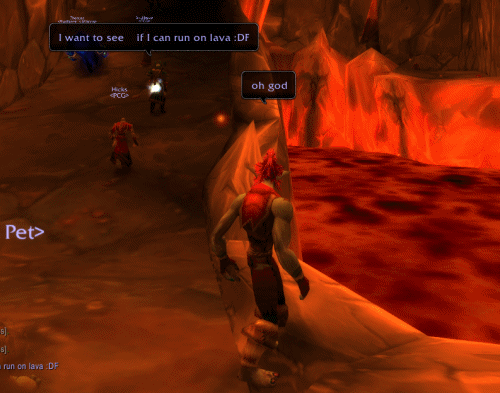
GTA IV Shorts

Split Up (YouTube HD)
Original post:
As I guess you know if you follow me or @PC_Gamer on Twitter, I’ve put up the- what, third? GTA IV short made from our various antics. This one has the best beginning, and the best ending, of mine. The middle is meandering glitchy madness to tie the two together. The high-def version is on YouTube – there’s a sentence that would have sounded strange a year ago.
Most of the popular ones on Rockstar Social Club are multiminute stuntwank epics nailed together from several clips of footage – mine are all single clips, simply because cuts are a pain in the jerk to jerk around with. I have – eep – 33 of these bastards I’ve edited, and I’m going to be hurling up one a day this week, unless I, like, don’t. I’ll update this post with links.
Keeping The Peace In Mirror’s Edge
It turns out that if you start talking about Mirror’s Edge in the Future offices, pretty soon a small crowd gathers to weigh in. In a group of editors and writers – one who gave it nine out of ten and another who thinks five was too high – it turns out we mostly agree. We all love to run, and we all get angry when we’re stopped by something difficult.
Most of my suggestions for the combat with cops would make it less difficult, and hopefully less awkward. But it can’t get so easy that you don’t feel threatened, and the grander issue is that it needs to be more avoidable. So this is about that.
The police choppers already work well as a propulsive force for the chase sequences that doesn’t often lead to death or frustration. But I’d like to change each of the three types of ground enemies, and how they’re used.
Cops: Not allowed to fire until they’ve issued two verbal warnings (“Freeze!” – “Stop or I will shoot!”) giving you a window to take one out or escape. Obviously once you’ve attacked one, others in the area can open fire. When they do hit, damage is much more serious – two hits kill – but they’re still wildly inaccurate. It becomes more of a tactical puzzle about how not to get shot, and the way forward never depends on turning a slow valve, climbing a slow pipe or working out where to head.
SWAT: Armoured and with two-handed weapons, these guys can’t be disarmed. But they’re only ever sent after you, so you never have to get past them to progress. They can be killed with stolen cop weapons, knocked out if you drop on them, or pushed into danger by a melee attack.
Chasers: Right now these guys have tazers, which are just kind of annoying. I think they should have mace. They should be knocked back by any melee move – to their death if they’re on a ledge – but if they get right up to you, they grab you and spray a blinding teargas in your eyes, sending your vision haywire and making you scream. You can try to flee while blinded, but if you don’t get away your third macing incapacitates you, and it’s game over.
Being chased was the perfect way to escalate Mirror’s Edge, but the Pursuit Cops are just so lame in combat; dancing about, tickling you with electricity and mild punching. I want to be freaking terrified of these guys. It would help if they didn’t look like dorks.
So one set is easy to deal with, another is hard to deal with but easy to avoid, and the last is hard to deal with or avoid – so do whichever you’re best at. I found lots of fun ways to lure Chasers into positions where I could knock them off a building, but bizarre rules meant that more often than not, I was the one knocked back by the crucial blow.
I was saying the other day that no matter how often the game explicitly tells you to stop and fight, the player still tries to run right past. Replaying the early sections at lunch today, I realised there’s actually a forced pop-up message in the prologue chapter that says “Always try to get away from enemies.” It couldn’t feel more like two different games that were code-merged at the last minute.
Trash Television
Dealing with the categories for this mini-redesign, I realised I hadn’t mentioned television in ages. Here’s a quick round-up of things you’re mostly probably not watching and mostly probably shouldn’t be.
Lost: Season one: I like everything about this show except Jack.
Season two: I like everything about this show except Jack and Kate.
Season three: I like everything about this show except Jack, Kate and Sawyer.
Season four: I like everything about this show except Jack, Kate, Sawyer and Ben.
Season five: I like everything about this show except Jack, Kate, Sawyer, Ben, Locke, Sun, Juliet, Charlotte and the plot.
Damages: Something about the style, tone and performances is still gripping, but every part of the plot this season is inferior. The main one’s a really tired cliché, Timothy Olyphant’s feels arbitrary and improbable, and the callback to the last season hinges on someone we saw shot still being alive – don’t ever, ever do that.
24: These tropes are still fun no matter how many times they’re repeated. Jack having to achieve the impossible in service of the terrorists is a classic. I notice Fake Hillary Clinton is the first president of 24-land to act in any way presidential – the others seemed to think their advisors outranked them.
The Fringe: This ought to be trashy fun, but something about it really doesn’t work. I think it’s that it takes itself so goddamn seriously, and the lead actress, while talented, is so scowlingly concerned that she sucks the joy from the surrounding nonsense.
Lie To Me: Smug but entertaining. Tim Roth as a human lie-detector. The science is both more convincing and interesting than guff like CSI, and more relevant than the hilarious nonsense of Numbers, but of course still wildly exaggerated. The decision to back up some of their claims with quick flashes of famously ashamed, guilty or angry people showing shame, anger or guilt is a great trick.
Flight of the Conchords: Caught bits of this a few times when jetlagged in the States and it never clicked, but this new series has just been sublime. The Conchords are a real band and a fictional one, and this is a mockumentary made by the real one about the fictional one, with the story of their bad, meek indie performances sometimes told via the medium of their smart, genre-hopping real songs. This is their manly answer to the Black Eyed Peas’ famously dismal My Humps:
Morn Of Brawl
The Dawn of War 2 multiplayer beta went public on Steam last night, so I imagine everyone who cares has played it or is about to. I can’t talk about the full game much until my review goes online, since there’s still an embargo for internets.
I just want to mention that of the three very different ways to play – single-player, co-op and multiplayer/skirmish – this is the least satisfying. It is, however, the only way to play as the Eldar, Orks or Tyranids, so get that out of your system as much as is feasible.
If you’re not much into RTS multiplayer, you can play this beta just against the AI. But doing so bears almost no relation to the real single-player game – it’s not even in the same genre.
Update: Just one more thing…
I think the worst thing about DoW2 multiplayer is that it always ends just as it’s getting good. I can’t play Annihilation because the bases are just so tediously tough – it seems to take hours to destroy them, during which you’re just watching a healthbar go down rather than smashing up power generators and barracks as you might be in a normal RTS.
But the Victory Point mode, while strategically more interesting, just freaking stops. In my review I say the rounds are too short, and they are, but I’ve since had time to work out why they feel that way. When the enemy team run out of victory points, it’s when you feel like you’re just poised to crush them and are relishing the prospect. When it’s you, it’s when you feel like you’ve just turned the tide and are back in the game.
It’s irritating because the solution is so obvious. When one team runs out of Victory Points, the match shouldn’t end. Instead, the nigh-invincible shield that seemingly protects their bases should go down. All players receive a message that those three bases are now vulnerable, and the winning side quickly sweep in to smash them up.
It could even incorporate a comeback mechanic, where if the losing team are able to capture all three victory points before the winners destroy their base, they’re protected again and will start to regain Victory points.
Trust Me With Your Ears: Volume Four

A regular feature in which I ask you to listen to a sound file with no idea what it’s going to be. A very, very short one this time, and hopefully mysterious. I’ll reveal its identity and why it’s interesting in the comments tomorrow, but beat me to it if you can.
The Combat In Mirror’s Edge And Why It Fucking Sucks
Having played it through three times in English and once in Italian, it’s starting to look like I might be obsessed with Mirror’s Edge. This is my fifth post about it, and not my last. But even I think the combat is weirdly bad, and so easily fixable that you start to wonder what went on in DICE’s offices. There’s no way they had a roomful of testers play this and everyone said “Yep, seems fine.”
The three parts of it suck in different ways, and my proposed fixes are of equal obviosity.
Like Tuesdays, the melee combat in Mirror’s Edge has no feel. Despite loading-screen guff about run-ups giving your flying kicks more damage, every blow bounces off every enemy, triggering a fake ‘stagger’ animation. Nothing is physical, everything is the result of abstract rules.
If I, an unarmed action hero, manage to run at a firing gunman and flying-kick him in the face before he kills me, it has to knock him down. Look into your hearts, DICE, you know this to be true. It’s a fundamental axiom of awesome, like glass breaking when I dive through it. The same goes for slide-kicks to the groin, which should lift your victim momentarily from the ground as he’s propelled backwards onto his ass.
Punches should be weak, of course, which is precisely why there shouldn’t be any. You’re a slim woman with unprotected hands, it’s just not wise to hit someone wearing full body armour. If you’re sprinting when you collide with them, the impact should make them stagger. If you’re stationary, Attack should do the same as Disarm – recall that the Disarm button is actually the “Beat them up and disarm them” button.
Waiting for an enemy’s weapon to flash red during a specific frame of the same nonsensical shoulder-nudge they each perform is preposterous. I feel like I’m standing there as a favour to the game’s animators, because they only know how to show me grabbing a wrist in one particular position. It’s a terrible challenge, relying either on using slow-mo so slow that the wait becomes boring, or learning the animations by rote to anticipate the absurdly brief red flash.
Design tip! You’re supposed to hide – not force me to study – ridiculous conceits like canned animations.
Disarming should always work – slowly if they’re firing at you when you initiate it, quickly if they’re staggered or prone. Enemies shouldn’t try to nudge you with their weapons in close combat: you’re still in front of their gun, there’s no reason for them to stop firing. Instead they should start to run backwards as you approach, trying to keep you at a distance.
I love all the different words reviewers have found for this: loose, hollow, shaky, weak, fuzzy, bland. Obviously to make an unprecedented free-running game you can’t devote the time and budget it would take to make a really punchy shooter too. I wish DICE had seen the bright side of this, though: they didn’t have to! Shooting doesn’t have to take up the player’s time or be their source of fun. You can just have guns outright fucking kill people, the way they actually would.
Hitman’s the closest model of what I’m talking about: it doesn’t make a great shooter and it doesn’t have to. You spend most of your time in situations where you can’t viably open fire, so enemies don’t have to be tough and interesting challenges when you do. They can just die.
Once you’ve got hold of a gun in Mirror’s Edge, it should make a lot of noise, have a lot of kick, miss a lot at range, but kill when it hits.
If some of this sounds like it would make the combat too easy, that might be because I think the combat should be easy. But I also think it should be used in a completely different way, and I think I’m going to have to make that post number 6.
P.S. Graham’s blog Zeitgasm has also been redesigned, and is also harping on about Mirror’s Edge in tones I mostly agree with. 83% though, honestly.
Art And Motion In Mirror’s Edge

PC Gamer’s wildly inaccurate review of Mirror’s Edge went up recently, in which Graham Smith criminally under-rates the game at 83%. My own review, for PC Format, gives it the score it so obviously deserves – 84%. Unfortunately they don’t put their reviews online, so run-don’t-walk to your local newsagents – or to the United Kingdom if you’re not already there.
The colours in Mirror’s Edge look like the cordial from which normal hues are diluted. They’ve found a new way of rendering them that dazzles, almost glows. Even when it’s just a warehouse or factory you’re clambering through, every surface has that fresh paint smell, newly dried matte too smooth and lustrous to have ever been touched. There’s the sad sense of a city gleamingly maintained but otherwise unused.

But beyond that, the design of the place constantly excites me. It’s the burden of level artists that they can’t just be level artists, they have to be architects, interior decorators, graphic designers, key grips, feng shui consultants and engineers. The buildings of Mirror’s Edge suggest its level artists actually are architects, interior decorators and graphic designers, moonlighting at DICE for some extra cash. If there are real offices that look this hip, I’m applying.
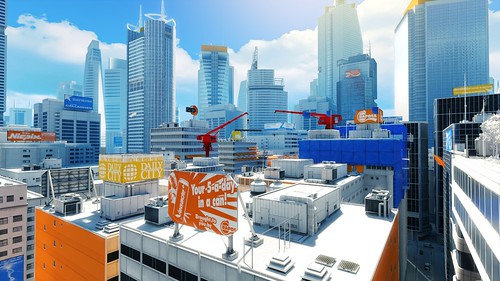
The game’s acceleration-based first-person parkour movement system does scratch the N itch, as I’d hoped. The second time through, with the route-highlighting Runner Vision off, is a new experience. This time you speak the language of the levels, and can pronounce your responses with new and fluid verbs. What I appreciate most about it, over third-person platformers, is the freedom of direction when launching myself from whatever wall I’m clung to, running along or flipping from – it gives scope for an elegance that isn’t pre-orchestrated like Prince of Persia’s.

I’m not keenly interested in major shortcuts – the fastest possible routes skip large chunks of the levels, but they’re large chunks I like. For me the finesse is in corner-cutting on a smaller scale: jumping to the center of a high-beam instead of tip-toeing its whole length, tucking to clear a huge jump fully rather than hauling yourself over the threshold, wallspringing to avoid a slow pipe clamber.
Strung together, flourishes like this surf the game’s acceleration mechanic and cannon you into a hurtling pelt. The little thrill of extra speed you get for vaulting an obstacle is a subtle but satisfying pat on the back for mastering the game’s unique nuances of environmental interaction.
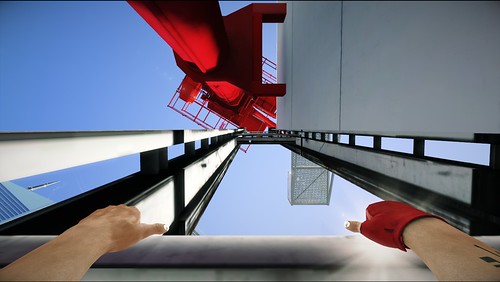
The main thing wrong with the platforming is the grabbing logic – it’s inconsistent, and it can’t afford to be. Some objects, like bars, can be grasped when your hands are more than a foot away, other ledges I’ve physically hit and still wasn’t able to hang onto. The platforming was never too difficult, to me, but every time I died without knowing why my character didn’t grab the ledge to which I’d propelled her, the irritation was vast.
Of course, that’s not the main thing wrong with Mirror’s Edge. Find out what is in my next post: The Combat In Mirror’s Edge And Why It Fucking Sucks.
P.S. If you hear any drilling, notice any scaffolds or strange new constructions around here, it’s because I’m tinkering behind the scenes a bit. James 2.7 will, I think, go up bit by bit over the course of this week. It’s too hard to prototype most of this stuff offline.


